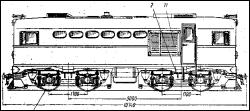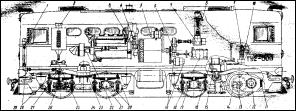|
Series TU2 ("Teplovoz Uzkokoleyny" - "Narrow-Gauge Diesel
Locomotive") diesel locomotives (gauge 750 mm) were made by
the Kaluga Machine Building Plant in 1956-1959. Altogether, more
than 300 (not less than 274) machines were built. TU2 is a
cargo-passenger, single-section, two cockpit diesel locomotive
with electric transmission.
The construction of TU2s began for two major reasons. First, somewhere
in 1956 the Soviet government ordered that steam traction should
vanish from all the Soviet railways as an attribute of the Dark
Capitalist Past and an obsticle en route to the Bright Communist
Future. Existing narrow-gauge low-power gas locomotives ("motovoz")
were too weak to pull long passenger and freight trains, and a new,
more powerful locomotive was immediately designed. (By the way, there
used to be TU1, too! The only sample of that creature has been cut
into pieces in Kiev, Ukraine, in 1999.) The second reason was
that at the same time the development of the Virgin Lands ("Tselina")
in northern Kazakhstan began, and a plenty of NG lines were
constructed to connect wheat and rye fields to grain silos. So, the
demand for a cheap powerful NG loco was overwhelming.
The fiels tests were conducted on the experimental ring of
TsNI MPS (Central Scientific Research Institute of the Ministry
of Railways) in Shatura. The ring existed up to 1972. Special
speed trials were conducted in Estonia near the town of P"arnu,
where the locomotive TU2-140 reached the speed of 76 km/h. The
design of bogies and the state of the tracks did not make it
possible to permit its operation at the speeds of more than 50
km/h. Diesel locomotives TU2 and TU4 were field tested almost
simultaneously. The TU2 was mentioned for the first time in the
newspaper Gudok ("Whistle") in the fall of 1955.
The only regular lines that keeps running TU2s are: Mikhailovka
network, Beregovo network, Antonovka network, and Gaivoron network in
the Ukraine. The latter network used to be quite extensive
(450+ km of main tracks!) However, it has been in constant decline
since the early 90's. The only remaining section, ca. 100 km long,
sees no more than one daily pair of trains. By the way, this is the
only Russian NG system that used sleeping coaches!
There used to be an industrial railways in Nizhni Tagil and
Alapaevsk.
Kazakhstan still has a number of NG lines serving its northern Virgin
Lands. Reportedly, one of these lines still works. It used to have
TU2s, but I am not sure if they are still in service.
Altogether, 105 out of 274 may be reliably in service. 12 of them
belong to the Panevezys network in Lithuania which has been closed but
not entirely lifted. They are in runnable condition, but their future
is uncertain (pretty much like the future of the line itself).
Most of state-owned revenue NG lines have been closed by year 1980
(with the exception of the four lines mentioned above). That was a
noticeable blow to the population of TU2s. Another problem with them
was that they were easy to break and hard to repair. The only shop
that was capable of fixing TU2s was in Gaivoron. They were not good to
use on
forestry and peat lines, either, because they were too heavy for
temporary peat and lumber tracks and did not fit into sharp curves, so
plentiful on turf bogs and timber mills. So, eventually most of them
has been cut, and some operate on the Children ("Pioneer") railways.
|














